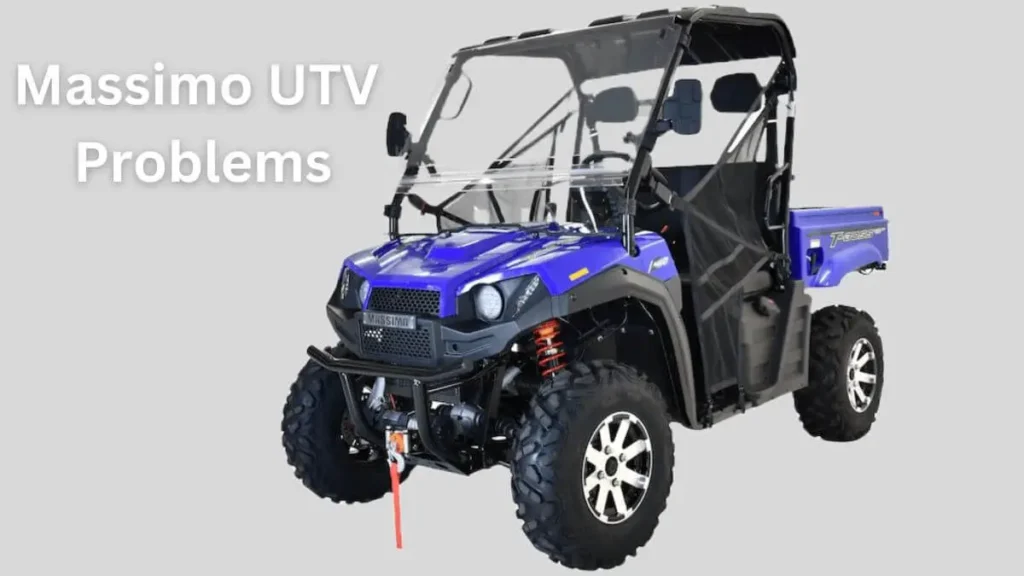The Massimo T-Boss 550 is great at handling rough terrain like dirt, sand washing, and rocks, making it a solid choice for road enthusiasts. Equipped with a robust 493cc EFI engine with 33 HP, this UTV offers speeds up to 45 mph; to win on any road, They get a lot of power. The Massimo T-Boss 550 starts at $8,199, providing a fully loaded UTV packed with essentials that would normally be much more expensive in other aspects.
However, the Massimo T-Boss 550 is poor for those seeking a high-speed performance machine or a UTV with luxurious interior features, as it is designed primarily for rugged off-road use rather than comfort or speed on highways. While it performs excellently in dirt and uneven terrains, it may not satisfy those looking for the same level of refinement found in other more premium models like the Trail Boss 550. Despite these limitations, the T Boss continues to be a popular choice among off-roaders thanks to its reliability, utility, and affordable price range.
The Massimo T-Boss 550 is a versatile UTV that stands out in its class for delivering an impressive combination of power and durability.
What type of engine does the Massimo T-Boss 550 have?
The Massimo T-Boss 550 is powered by a 493cc 33HP engine paired with an in-cabin selectable 4WD Shaft-Driven powertrain, giving this single-cylinder EFI engine great terrain capability, fuel efficiency good for improved performance and reliability -It provides injection, which is perfect for off-road adventure.
What is the engine displacement of the Massimo T-Boss 550?
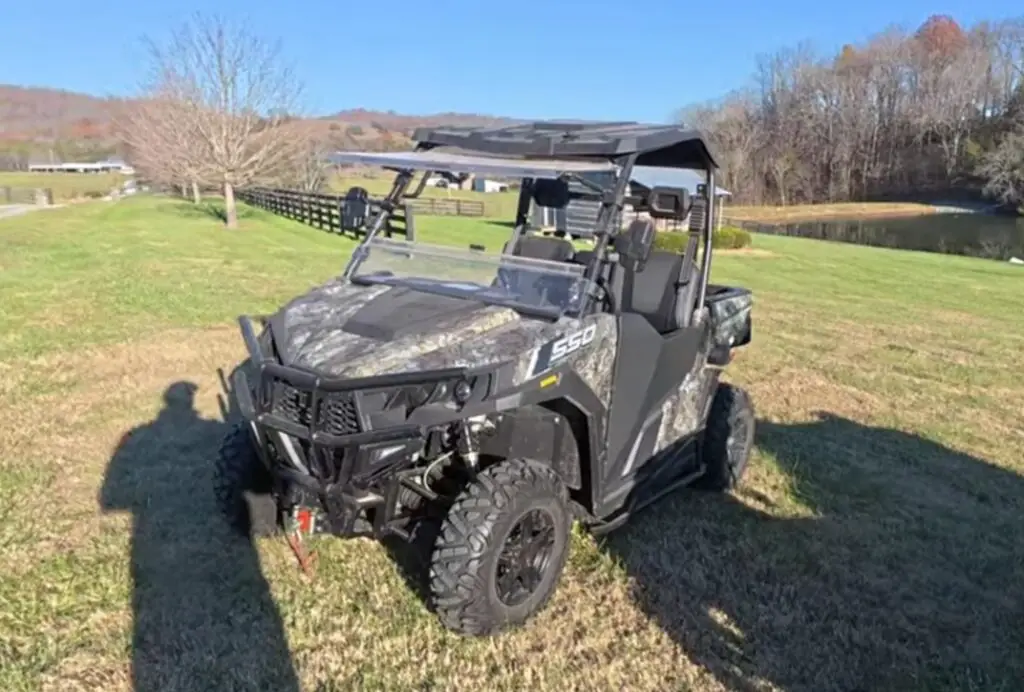
The Massimo T-Boss 550 features a 493 cc engine, providing a solid balance of power and performance for off-road adventures. The engine capacity or engine size is designed for rugged terrains, offering excellent torque and durability. With a maximum speed of 45 mph, this UTV delivers a satisfying ride. The cylinder capacity and swept volume contribute to its overall power, making it ideal for challenging environments.
What type of fuel system does the Massimo T-Boss 550 use?
To distribute gasoline efficiently, the Massimo T-Boss 550 employs an Electronic fuel injection system. FUEL TANK, STEEL is included to provide a dependable fuel supply for off-road excursions.
What is the fuel capacity of the Massimo T-Boss 550?
The fuel capacity of the Massimo T-Boss 550 is 6.9 gallons.
What type of starting system does the Massimo T-Boss 550 feature?
The Massimo T-Boss 550 features an easy-to-use Start Type Electric system. This allows for quick and reliable starts, providing convenience and efficiency during off-road adventures and harsh conditions.
What is the final drive mechanism in the Massimo T-Boss 550?
Massimo T-Boss 550 features an independent A-arm final drive mechanism that gives superb handling and comfort.
What is the front suspension travel of the Massimo T-Boss 550?
The Massimo T-Boss 550 has 7 inches of front suspension travel.
What is the rear suspension travel of the Massimo T-Boss 550?
7 inches rear suspension is available in the Massimo T-Boss 550.
What are the tire specifications for the front wheels of the Massimo T-Boss 550?
The front tires of a Massimo T-Boss 550 are measured 25x8x12.
What are the tire specifications for the rear wheels of the Massimo T-Boss 550?
The rear wheels of the Massimo T-Boss 550 are fitted with 25×10-12 tires.
What type of brakes does the Massimo T-Boss 550 have in the front?
The Massimo T-Boss 550 is fitted with twin hydraulic disc brakes at the front.
What type of brakes does the Massimo T-Boss 550 have in the rear?
Massimo T-Boss 550 Rear brake is a hydraulic disc brake.
What is the wheelbase of the Massimo T-Boss 550?
Massimo T-Boss 550 has a wheelbase of 1855 mm.
What are the length, width, and height dimensions of the Massimo T-Boss 550?
Table of the length, width, and height dimensions of the Massimo T-Boss 550.
| Length | 103.5 inches |
| Width | 54 inches |
| Height | 76 inches |
What is the ground clearance of the Massimo T-Boss 550?
Massimo T-Boss 550 has a ground clearance of 9.3 inches.
What is the cargo bed capacity of the Massimo T-Boss 550?
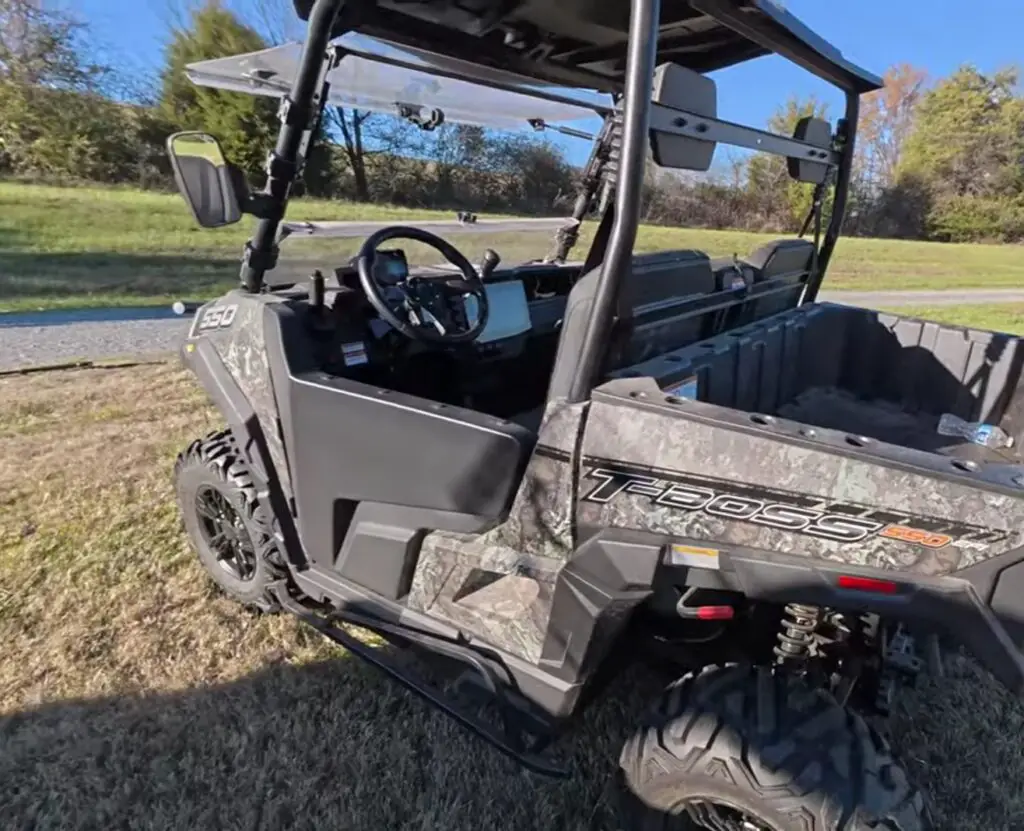
This massive 550 Massimo T-Boss features a 400-pound cargo bed for transporting goods or machines across rugged ground surfaces and very off-road interior trails.
What is the towing capacity of the Massimo T-Boss 550?
Massimo T-Boss 550’s towing capacity is 1200 pounds.
What is the curb weight of the Massimo T-Boss 550?
The curb weight of the Massimo T-Boss 550 is 999 pounds.
What color options are available for the Massimo T-Boss 550?
You will get The Massimo T-Boss 550 in a variety of colors, like red, blue, camouflage, and white.
What is the MSRP of the Massimo T-Boss 550?
The MSRP of the Massimo T-Boss 550 is $8,199.
Does the Massimo T-Boss 550 have a touchscreen?
Yes, The Massimo T-Boss 550 has a 7-inch touchscreen display. It gives you all the important data about your driving and vehicle.
What is the top speed of the Massimo T-Boss 550?
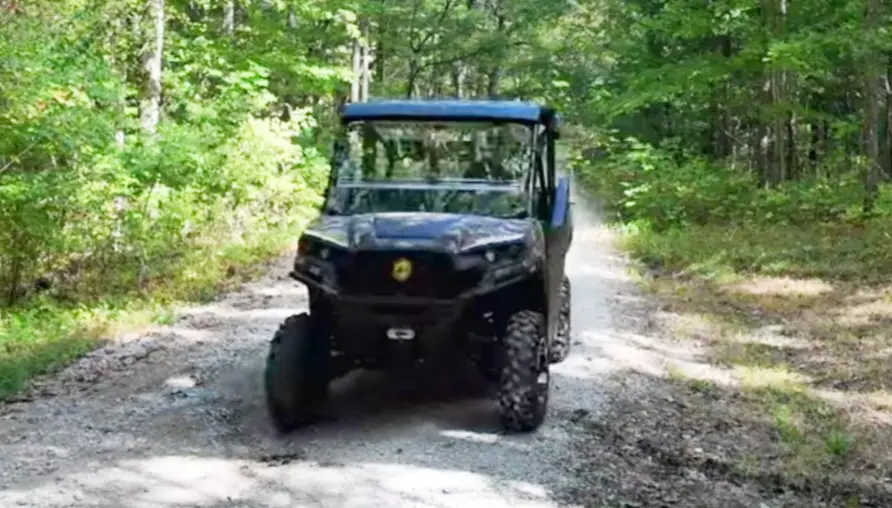
Massimo T-Boss 550’s top speed is 45 MPH.
Does the Massimo T-Boss 550 come with a half door?
Yes, the Massimo T-Boss 550 comes equipped with a half door, providing added protection while allowing easy access and maintaining an open-air feel for off-road adventures.
How good are the speakers in the Massimo T-Boss 550?
The Massimo T-Boss 550 features decent speakers, providing clear audio quality. While they excel for casual music or communication, audiophiles may find the system lacking in premium sound depth.
What is the oil capacity of the Massimo T-Boss 550?
Massimo T-Boss 550 has an oil capacity of 2 quarts.
Which oil filter is suitable for the Massimo T-Boss 550?
The Massimo T-Boss 550 is compatible with a standard spin-on oil filter designed for its 493cc EFI engine, ensuring optimal oil flow and engine protection during demanding off-road conditions.
Who manufactures the Massimo T-Boss 550?
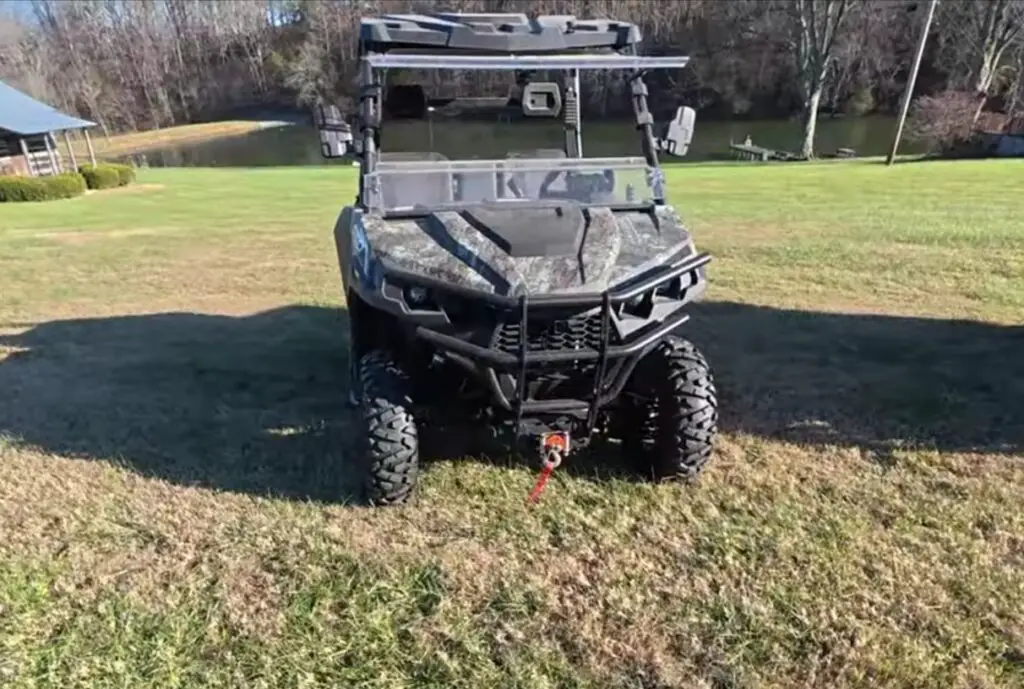
The Massimo T-Boss 550 is from a known UTV brand that comes from the Massimo Group and is sold by dealers like Ecofun Motorsports to be claimed as a high-end Off-road vehicle.
What type of vehicle is the Massimo T-Boss 550, and how does it function as a side-by-side quad UTV?
Massimo T-Boss 550 is a UTV Side-by-side off-roading vehicle.
What colors are available for the Massimo T-Boss 550?
Massimo T-Boss 550 is available in a variety of colors, including red, white, blue, and camouflage.
How durable are the Massimo T-Boss 550 parts, and how reliable is it overall?
The Massimo T-Boss 550 parts are highly durable and designed for rugged use. Its robust construction and reliable engineering ensure consistent performance in harsh terrains, making it dependable for off-road adventures.
Is the Massimo T-Boss 550 sold at Tractor Supply a good UTV?
The Massimo T-Boss 550 sold at Tractor Supply is a solid UTV, offering good value for its price, robust performance with its A-Arm With Adjustable Preload, and reliable off-road capabilities, though not luxurious.
What does the Massimo T-Boss 550 test reveal about its structure and durability?

The Massimo T-Boss 550 tests reveal a robust structure, excelling in durability with its heavy-duty frame and A-Arm With Adjustable Preload suspension, making it ideal for tough off-road environments.
How does the Massimo T-Boss 550 perform in the power department according to tests?
The Massimo T-Boss 550 performs well in power, thanks to its robust 493cc EFI engine with 33 HP. Tests show it offers sufficient power for off-road tasks and tackling tough terrains.
What do tests reveal about the interior features of the Massimo T-Boss 550?
Tests reveal that the Massimo T-Boss 550 has a basic interior with functional features, but lacks premium amenities. While durable, the cabin may not satisfy those seeking advanced comfort or luxury.
How does the Massimo T-Boss 550 perform out on the range during tests?
The Massimo T-Boss 550 performs exceptionally well out on the range during tests, handling dirt and sand washes with rocks with ease, thanks to its robust 493cc EFI engine and durable suspension.
Is there a lift kit available for the Massimo T-Boss 550?
Yes, a Lift kit is available for the Massimo T-Boss 550 that will give you better ground clearance.
What do consumer reviews from Consumer Reports say about the Massimo T-Boss 550?
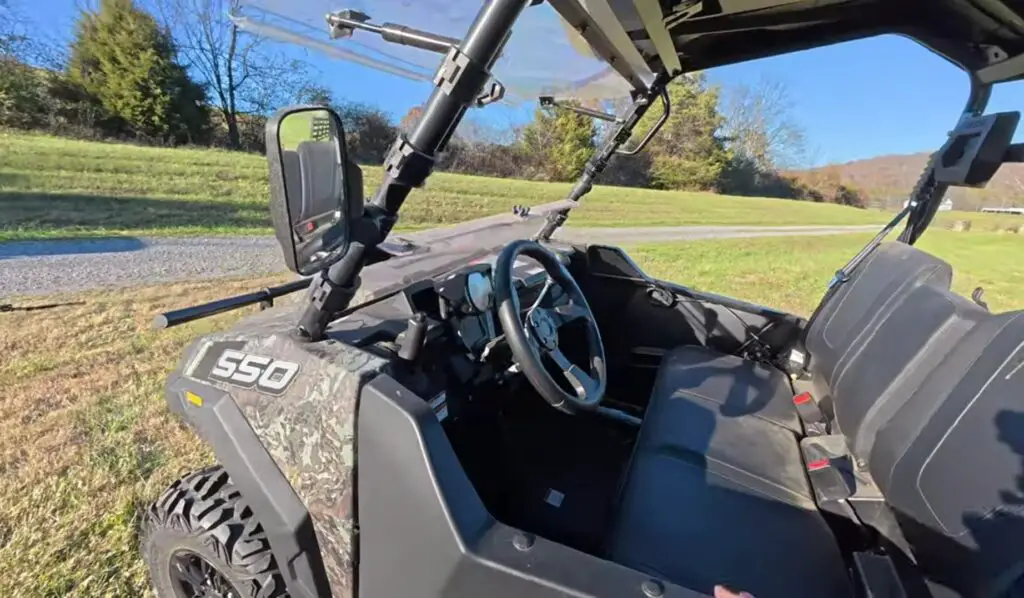
Consumer reviews from consumer reports say that the Massimo T-Boss 550 is praised for its affordability and longevity.
How does the Massimo T-Boss 550 compare to the Massimo T-Boss 560?
Massimo T-Boss 550 has a 493cc, 33 HP engine, and The T-Boss 560 gives you more power with the 561cc engine.
How reliable is the Massimo T-Boss 550?
The Massimo T-Boss 550 is generally reliable, with its durable build and A-Arm With Adjustable Preload suspension handling rough terrains well. However, like any UTV, regular maintenance is key for longevity.
Does the Massimo T-Boss 550 come with a flip windshield?
Yes, the Massimo T-Boss 550 comes with an optional swivel windshield, which provides additional protection from debris and wind while driving, and enhances comfort for off-road travel in the air in various circumstances.
What are some common problems associated with the Massimo T-Boss 550?
Common problems with the Massimo T-Boss 550 include overheating issues, battery drainage, and suspension wear. These problems are often related to A-Arm With Adjustable Preload and engine stress under heavy use.
Does the Massimo T-Boss 550 feature on-demand 4WD?

The Massimo T-Boss 550 is equipped with the on-demand 4WD. This driving mode gives you superb handling and traction for Off-road driving.
How effective is the electronic fuel injection (EFI) system in the Massimo T-Boss 550?
Massimo T-Boss 550 Electronic Fuel Injection (EFI) technology ensures the optimal supply of fuel for reliable, trustworthy cold starts and continued operation, even when off-road and at high altitudes.
What is the size of the Massimo T-Boss 550 UTV?
Table of the size of the Massimo T-Boss 550.
| Length | 103.5 inches |
| Width | 54 inches |
| Height | 76 inches |
What is the price of the Massimo T-Boss 550?
The Massimo T-Boss 550 starts at $8,199. This fully loaded UTV offers great value with its powerful engine, advanced suspension, and durable materials suitable for off-road adventures.
What are the key specifications of the Massimo T-Boss 550?
Key specifications of the Massimo T-Boss 550 are listed below.
- 493cc EFI engine with 33 HP.
- Speeds up to 45 mph.
- 7-inch rear suspension travel.
- A-Arm With Adjustable Preload.
- CVT automatic transmission.
- Full-time 4WD.
- The price is $8,199.
- 400 lbs Cargo capacity.
- 1,200 lbs Towing capacity
What accessories are available for the Massimo T-Boss 550?
The Massimo T-Boss 550 offers various accessories. Below is the list of accessories.
1. Windshields
2. Roofs
3. Gun Racks
4. LED Lights
5. Winches
6. Mirrors
7. Seat Covers
8. Tires
9. Cargo Racks
10. Audio Systems
11. Door Kits
12. Roll Cages
Where can I find the parts catalog for the Massimo T-Boss 550?
You can find the parts catalog for the Massimo T-Boss 550 through the following sources.
1. Massimo Motor’s official website
2. Authorized Massimo dealerships
3. Online UTV parts retailers
4. Massimo T-Boss 550 owner forums
5. Third-party parts suppliers
What is the overall review of the Massimo T-Boss 550L?
The Massimo T-Boss 550L is Good for off-road enthusiasts who want solid performance and durability but bad for those in the market for high-speed capability or luxury features.
What does the parts diagram of the Massimo T-Boss 550L look like?

Is the Massimo T-Boss 550L available for under $6000?
No, the Massimo T-Boss 550L is not available for under $6000. It typically costs around $8,199, offering a fully loaded UTV with impressive features like a robust 493cc EFI engine.
How do I replace the air filter for the Massimo T-Boss 550L, and where can I find its cover, location, and kit?
To change the air filter on the Massimo T-Boss 550L, find the cover on the engine side, take it off, and put a new filter in. You may purchase air filters online or from authorized dealers.
What is the size of the air filter used in the Massimo T-Boss 550L?
The Massimo T-Boss 550L uses two-phase airflow to ensure optimal engine performance and protection from dirt and debris in off-road conditions The air filter is designed to filter dust and particulate matter well, for car engine health when riding in heavy traffic What is important is the air filter The design has been specially designed to match the car’s 493cc EFI engine aligned, providing the air necessary for efficient engine operation. Regular maintenance and cleaning of the air filters is essential to keep them running and ensure the longevity of the T-Boss 550L, especially when traveling over difficult terrain.
What is the cross-reference and part number for the Massimo T-Boss 550L air filter?
The cross-reference and part number for the Massimo T-Boss 550L air filter is HF152, which is compatible with several UTV models. It’s essential to use the correct part number to maintain engine performance and efficiency.
What features does the Massimo T-Boss 550F 493-cc UTV offer?
Massimo T-Boss 550F 493cc UTV offers you a strong 493cc with a 33-horsepower engine. This UTV also features an A-arm suspension and 10-inch rear suspension.
What are the differences between the 2022 and 2021 Massimo T-Boss 550 models?

Here is the table of differences between the 2022 and 2021 Massimo T-Boss 550 models.
| Feature | 2022 Model | 2021 Model |
| Engine | 493cc EFI, 33 HP | 493cc EFI, 33 HP |
| Suspension Travel | 7 inches rear | 7 inches rear |
| Price | $8,199 | $9,999 |
| New Feature | Improved controls | Standard features |
How does the Bennche T-Boss 550 compare to the Massimo T-Boss 550?
Here’s a quick overview table of the Bennche T-Boss 550 compared to the Massimo T-Boss 550.
| Feature | Massimo T-Boss 550 | Benche T-Boss 550 |
| Engine | 493cc EFI, 33 HP | 493cc EFI, 27 HP |
| Suspension Travel | 7 inches | 8 inches |
| Price | $8,199 | $10,263 |
| Top Speed | 45 mph | 45 mph |
Does the Massimo T-Boss 550 have a 2WD/4WD option?
Yes, the Massimo T-Boss 550 offers a 2WD/4WD option for versatile off-road performance.
How does the Massimo T-Boss 550 compare to the Polaris Ranger?
The Massimo T-Boss 550 vs Polaris Ranger comparison highlights key differences in performance, features, and price. While the Massimo T-Boss 550 offers great off-road capabilities at a lower price, the Polaris Ranger excels in refinement and advanced features. Below is a table summarizing the comparison:
| Feature | Massimo T-Boss 550 | Polaris Ranger |
| Engine | 493cc EFI, 33 HP | 567cc, 44 HP |
| Top Speed | 45 mph | 50 mph |
| Suspension Travel (rear) | 7 inches | 10 inches |
| Off-road capability | Excellent | Excellent |
| Towing capacity | 1200 lbs | 1500 lbs |
| Price | $8,199 | $11,699 |
What features stand out in the Camo version of the Massimo T-Boss 550?
The Massimo T-Boss 550 camo version is best for hunters and outdoor lovers. This camo version helps you to disappear in the wild.
How does the electric version of the Massimo T-Boss 550L compare to the Massimo T-Boss 550?
Compared to Massimo T-Boss 550, the 550L electric version is gas-free, silent, and environment friendly.
Why is the Massimo T-Boss 550 a versatile choice for outdoor enthusiasts, farmers, and landowners?
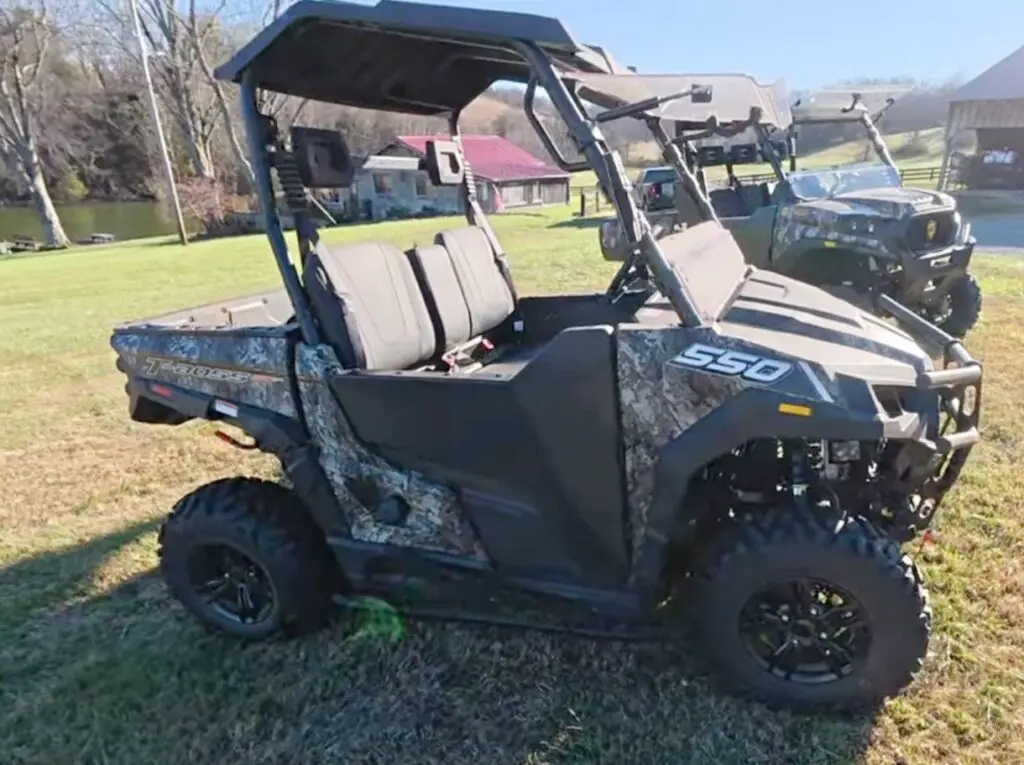
The Massimo T-Boss 550 has a powerful 493cc engine, a stable cabin, and an A-arm adjustable preload suspension to ensure farmers, landowners, and other outdoor lovers achieve their utility task vehicle goals.
Can we use Massimo T-boss 550 for work and recreation?
Yes, without any doubt, the Massimo T-Boss 550 is a great UTV for work and recreation because the Massimo T-Boss 550 has a sturdy construction and 1200 pounds of tremendous towing potential.
How does the 2021 Massimo T-Boss 550 compare to the 2019 Bennche T-Boss 550 and the 2020 Massimo T-Boss 550?
Table of 2021 Massimo T-Boss 550 compare to the 2019 Bennche T-Boss 550 and the 2020 Massimo T-Boss 550.
| Feature | 2021 Massimo T-Boss 550 | 2019 Benche T-Boss 550 | 2020 Massimo T-Boss 550 |
| Engine | 493cc EFI, 33 HP | 493cc EFI, 30 HP | 493cc EFI, 33 HP |
| Rear suspension travel | 7 inches | 9 inches | 10 inches |
| Price range | $8,199 | $9,774 | $10,263 |
| Top Speed | 45 mph | 45 mph | 45 mph |
What is unique about the Massimo T-Boss 550F model?
The Massimo T-Boss 550F model is unique for its fully enclosed cabin, providing enhanced comfort and protection from the elements, ideal for year-round off-road use. It also features automated transmission for easier handling.
What is the difference between the Massimo T-Boss 550X Golf 4-seater UTV and the standard model?
The Massimo T-Boss 550X Golf 4-seater offers additional features tailored for golf course use, such as a larger seating capacity and unique golf-specific accessories. In contrast, the standard Massimo T-Boss 550 is designed for more general off-road purposes. Here’s a comparison:
| Feature | Massimo T-Boss 550 | Massimo T-Boss 550X Golf 4-seater |
| Seating Capacity | 2 | 4 |
| Purpose | Off-road | Golf course use |
| Accessories | Basic Off-road | Golf related accessories |
| Price | $8,199 | Higher due to added features |
What are the key differences between the Massimo T-Boss 550 and Linhai UTV?
The Massimo T-Boss 550 and Linhai UTV differ in several aspects, including engine performance, suspension, and price. Here’s a comparison table:
Massimo T-Boss 550 vs Linhai UTV.
| Features | Massimo T-Boss 550 | Linhai UTV |
| Engine | 493cc EFI, 33 HP | 352cc, 20 HP |
| Suspension Travel | 10 inches rear | 8 inches rear |
| Price | $8,199 | $6,999 |
| Top Speed | 45 mph | 40 mph |
How does the T-Boss 550 perform in tough terrains?
The T-Boss 550 excels in rough terrain, thanks to its 2WD/4WD system for excellent traction. Its improved suspension ensures a smooth ride even on uneven rocks, increasing roadworthiness.
What makes the T-Boss 550’s fuel efficiency, powertrain, and handling reliable for diverse tasks?
The T-Boss 550’s fuel efficiency is enhanced by its robust 493cc EFI engine with 33 HP, providing a balance of power and economy. Its A-Arm with Adjustable Preload suspension ensures reliable handling across diverse terrains, making it ideal for a variety of off-road tasks.
Is the T-Boss 550 good for first-time UTV budget-conscious buyers?
Yes, the T-Boss 550 is a practical, affordable option for budget-minded first-time UTV buyers, offering reliable performance and features at a price that’s hard to. It strikes a balance between cost and durability, making off-road vehicles suitable for beginners.
How does the T-Boss 550 meet the needs of DIYers, property owners, and utility-focused users?
The T-Boss 550 meets the needs of DIYers, property owners, and utility-focused users, providing powerful off-road capability, ideal for heavy-duty and property protection with its comprehensive A-arm and durable adjustable preload suspension Engine for hauling, towing, and hard earth transportation.
What are some popular Massimo models similar to the T-boss 550?
Below is a list of some popular Massimo T-Boss models.
Massimo T-Boss 410
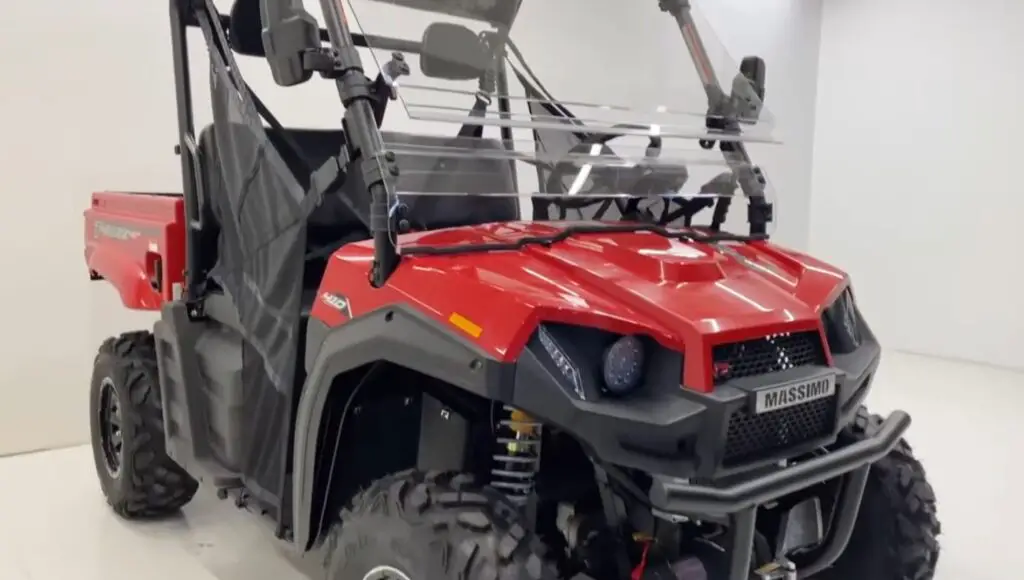
The Massimo T-Boss 410 is available in the market for $7,699. It features a 352cc, EFI engine.
Massimo T-Boss 750
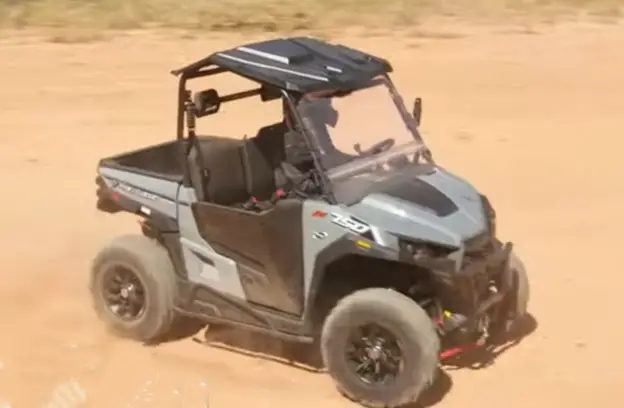
The Massimo T-Boss 750 features a 694cc engine. The Massimo T-Boss 750 has the towing capacity of 1500 lb.
Massimo T-Boss 760
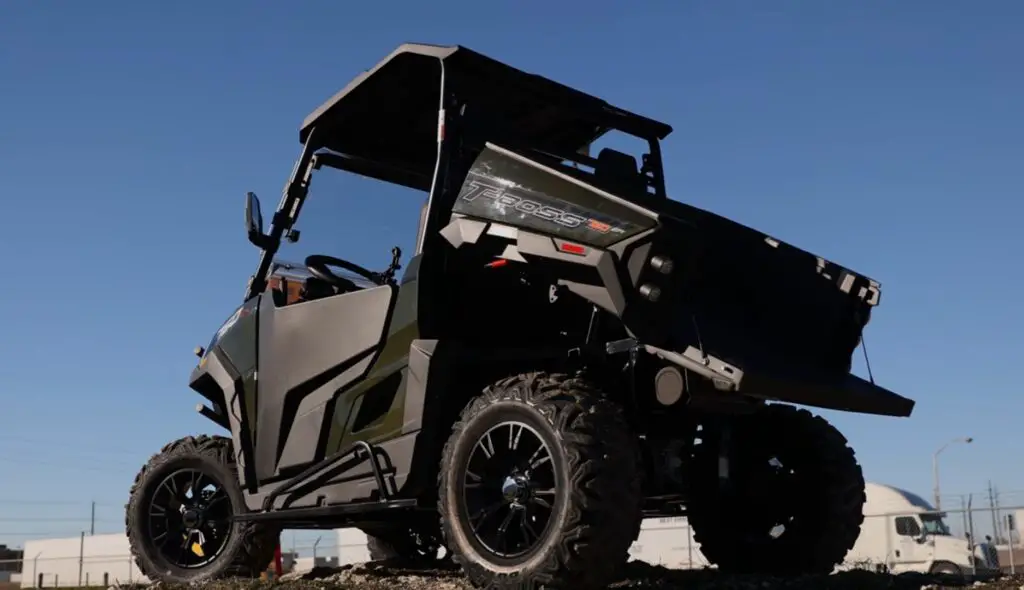
The Massimo T-Boss 760 comes with a 585cc engine. It has the towing capacity of up to 1500 lb.
Massimo T-Boss 560
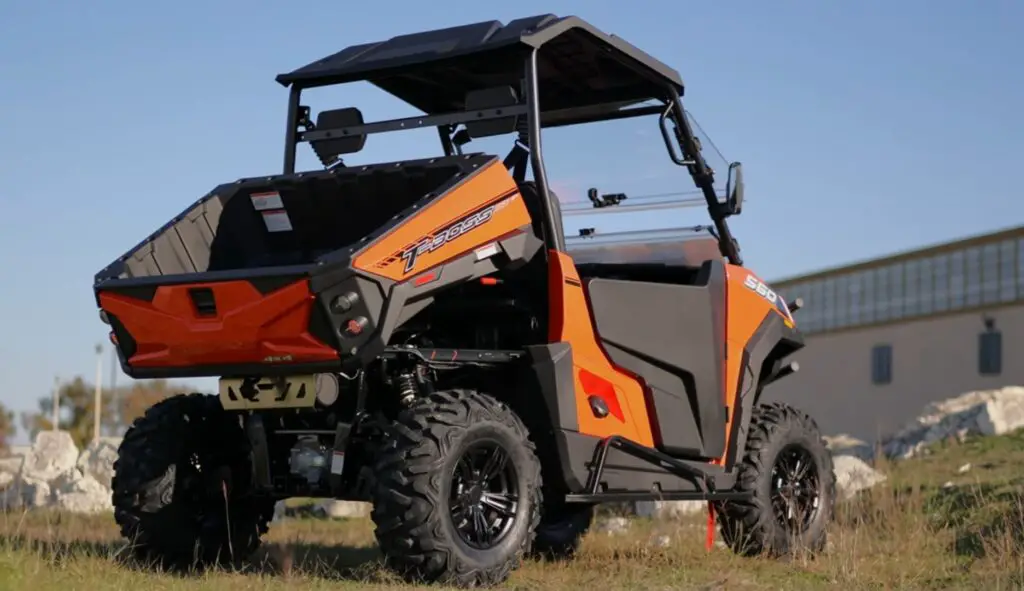
The cost of Massimo T-Boss 560 is $10,999. It features a 493cc, 33 HP engine.
Massimo T-Boss 1000
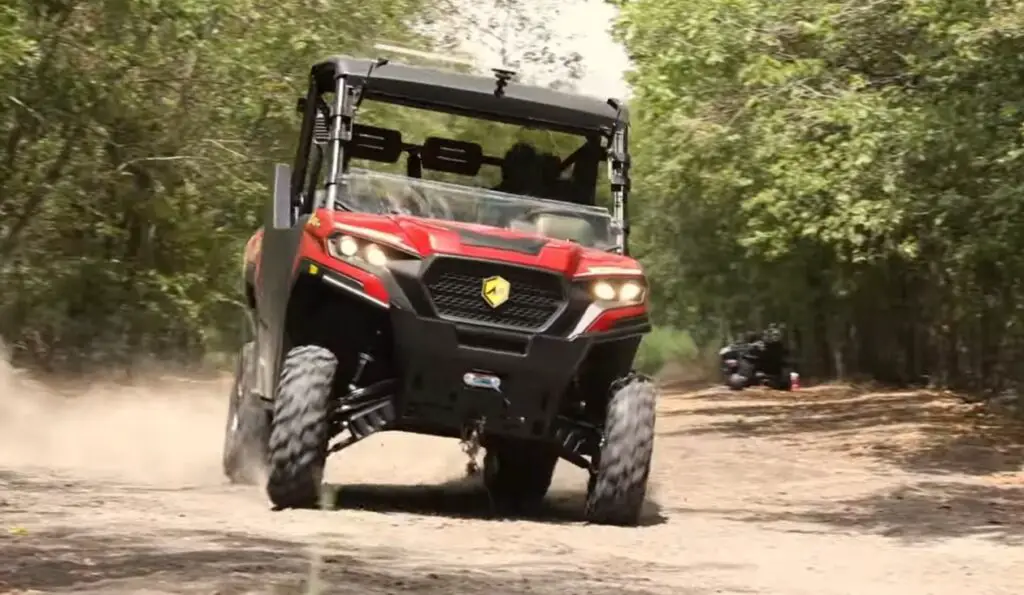
Massimo T-Boss 1000 is a very powerful off-roading UTV that features a strong 1000cc engine. It is available for $17,999.
Massimo T-Boss 550 UTV
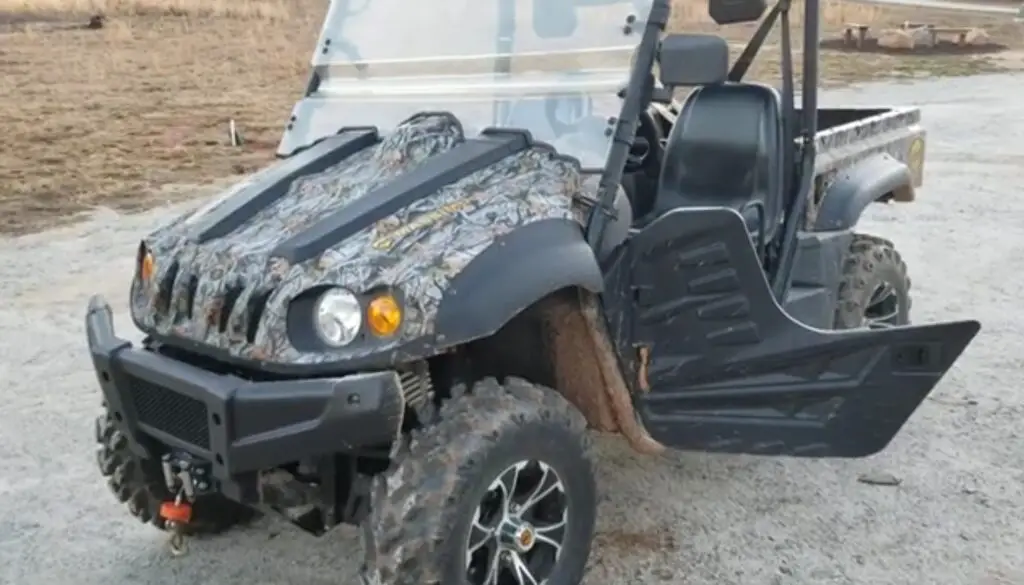
The Massimo T-Boss 550 UTV/ATV is equipped with a robust 493cc EFI engine delivering over 33 HP, making it best for off-road tours. Its robust construction and A-arm adjustable preload suspension supply splendid performance on challenging terrains.
Bighorn Explorer 550 4×4 EFI UTV
The Bighorn Explorer 550 4×4 EFI UTV gives great off-avenue capabilities and a dependable 550cc EFI engine, which makes it perfect for challenging terrains. Its strong 4×4 features and durable construction make it a notable choice for adventure lovers.
Massimo MSU 850 Side by Side UTV
The Massimo MSU 850 Side by Side UTV/ATV is a powerful utility vehicle at $12,000+, designed for recreational and heavy-duty use. It offers exceptional performance with a powerful engine, advanced suspension, and durable materials for off-road adventures.
Massimo Buck 250 Side by Side UTV 12HP
The Massimo Buck 250 Side by Side UTV features a 12HP engine, offering a compact and efficient off-road experience. Priced at $6,400, it provides great value for utility-focused users and small property owners.
Massimo Motor Sports T-Boss 760 UTV
The Massimo Motorsports T-Boss 760 UTV, priced at $ 11,000, is a high-performance vehicle designed for serious off-road lovers.
Its powerful engine and advanced technology let it function well on rough terrain.
MASSIMO MSU-850-5 UTV, Four Stroke 2 Cylinder V-Twin, Liquid Cooled
The MASSIMO MSU-850-5 UTV features a four-stroke 2-cylinder V-Twin engine with liquid cooling, providing powerful performance for demanding applications. Priced at $14,000+, it offers advanced power and advanced features for off-road enthusiasts.
Massimo Buck 250X Side by Side UTV
The Massimo Buck 250X, which costs $6,200 hundred, is a compact off-road car. Its high performance and friendly design make it perfect for each expert and leisure rider.
Massimo T-Boss 550 ATV
The Massimo T-Boss 550 is the best affordable off-road vehicle with a strong 493cc, four-stroke engine.
Massimo MSU 850 Side by Side ATV
Massimo MSU 850 is a powerful off-roading vehicle that features an 800cc, 4-stroke, liquid-cooled engine.
Massimo Buck 250X Side-by-Side ATV
Massimo Buck 250 comes with a single-cylinder, 177cc engine. This side-by-side has a top speed of 30-35 MPH.
What is the Massimo t boss 550l review? Is it good or bad?
The Massimo T-Boss 550L provides exceptional dynamics for driving, towing, and maneuvering over challenging terrain, making it a reliable choice for off-road enthusiasts. Its power output is backed by a 493cc EFI engine, which delivers the strength needed for intensive tasks. It can effortlessly handle harsh environments with complex structures. The attached cab protects from the weather, providing comfort even in severe weather conditions. Overall, this is a solid choice for user-focused developers.
What Does the parts diagram of Massimo T-Boss 550l look like?
The parts diagram of the Massimo T-Boss 550L usually contains detailed drawings of the engine, suspension, drivetrain, and electrical components. This gives a clear view of each part, helping with maintenance and repair.
What are the Massimo T-boss 550L under $6000
The Massimo T-Boss 550L itself is typically priced above $6000, but here are some Massimo models that are usually available under $6000.
1. Massimo T-Boss 410
2. Massimo MB200
3. Massimo Warrior 400
4. Massimo 500 UTV
5. Massimo Buck 250X Side by Side UTV/ATV
What is the Massimo T-boss 550l air filter replacement price, cover, location, and kit?
The Massimo T-Boss 550L air filter replacement kit typically costs around $30-$50. The air filter is located near the engine, and replacement usually involves removing the cover and accessing the filter compartment.
What is the size of the Massimo T-Boss 550l air filter?
The Massimo T-Boss 550L air filter typically has a size of 5.5 inches in diameter and 6.5 inches in length. This size ensures optimal airflow to the engine for efficient performance.
What is Massimo T-Boss ss 550l air filter cross reference?
The Massimo T-Boss 550L air filter cross-reference is typically HFA3001 or Hiflofiltro HF303 depending on the manufacturer.
What is the Massimo T-Boss oss 550l air filter part number?
The Massimo T-Boss 550L air filter part number is AF-550L.
The Massimo T-Boss 550 proves to be a solid choice for off-road enthusiasts looking for power and reliability. Massimo T-Boss 550 is good for tackling dirt and sand washes with rocks, thanks to its robust 493cc EFI engine with 33 HP and speeds up to 45 mph. However, the Massimo T-Boss 550 is bad for users seeking a high-performance machine for smooth highway driving or luxurious interiors. Massimo T-Boss 550 price ranges from $8,199, offering a fully loaded UTV perfect for utility and recreational use, although some might prefer the higher-end features of models like the Trail Boss 550.
The T-Boss 550 is your go-to for off-road adventures! Want more power? Learn about the Massimo T Boss 750 or the compact Massimo T Boss 410.
Subscribe for Our Latest Posts! Thank you!



